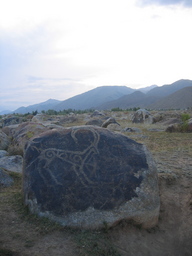
Hedgehog
2005.07.30 Cholpon Ata, Kyrgyzstan
|
|
I've spent my last nights in Kyrgyzstan visiting the village of Cholpon-Ata, on the shore of Issyk-Kul. The lake is so massive there are actually sandy beaches around it, thousands of miles from the nearest ocean. I waded around a bit, taking in the water; mountains; and plump, old Russian women sunning themselves in bikinis.
I'm staying in a local home again, this time with a young Russian family. It's so much harder to communicate, as they know neither Kyrgyz nor English; I have picked up maybe two-dozen words of Russian. Still, they're open and friendly, and I have a comfortable bed in a private room.
I had tried to find a local Kyrgyz family to stay with upon arrival. I met a friendly old Kyrgyz woman near the bus station holding out a sign, "KOMNAT", meaning "room for rent". We spoke for awhile; I figured she would be a good candidate to stay with. However, she was really just a shill for the family I did wind up staying with. When I realized that it was Russians I would be staying with I thought about looking for another homestay, but the young couple seemed like they needed the money. Both the man and woman appeared to be about 21 years old. The woman had a baby in her arms, and another on the way.
On my way back from the beach to the homestay I crossed paths with a hedgehog. I had never seen one in the wild, and thought they were rather uncommon. The poor thing was terrified of me, shuddering under brush while I tried to snap its photo.
 Petroglyph |
This evening I strolled northwest of Cholpon-Ata to a prehistoric site overlooking the lake. Atop a hill just on the edge of the settled area lay a vast field. Large stones and boulders were scattered throughout, I presume a result of glaciation from the last ice-age. What made the area interesting were etchings on the southern surfaces of many stones. Crudely drawn archers and more elaborate renderings of long-horned game were visble on many of the larger rocks.
After arriving at the field a woman greeted me, announcing herself to be the curator of the site. I was a bit suspicious at first, but she had bonafide looking documents with decent English translations, including nicely printed admission tickets. Even if it was a scam, she asked for only 25 som, which I figured I could part with.
We spoke for awhile; she was suprised that I could speak Kyrgyz. I've found it amusing that so many people in this region take my broken Uighur for their native language. I presumed that there would be more of a difference across the various Turkic languages. However, I've found Kazakh, Kyrygyz, Uzbek, Uighur--they're all fairly mutually intelligible.
I spoke with the curator for long enough to get a sense of the background of the area. It seems that over a thousand stones have markings. Most of the etchings are from the sixth century, though some date back into years B.C.. I found it an amusing contrast seeing goat-herders lead their flocks through the area, with animals not that different than those pictured on the stones.